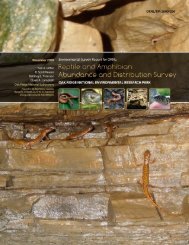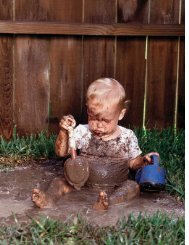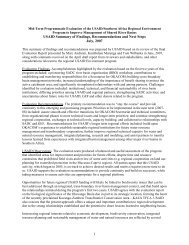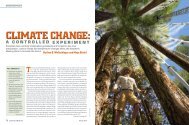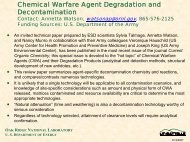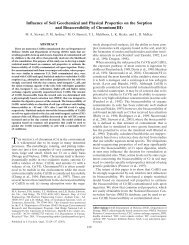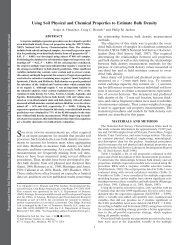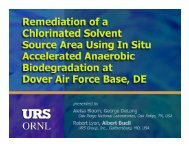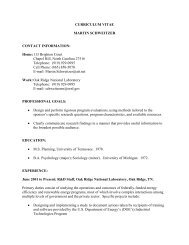The Effect of Soil Properties on Toxic Metal Bioavailability: Field ...
The Effect of Soil Properties on Toxic Metal Bioavailability: Field ...
The Effect of Soil Properties on Toxic Metal Bioavailability: Field ...
Create successful ePaper yourself
Turn your PDF publications into a flip-book with our unique Google optimized e-Paper software.
<str<strong>on</strong>g>The</str<strong>on</strong>g> <str<strong>on</strong>g>Effect</str<strong>on</strong>g> <str<strong>on</strong>g>of</str<strong>on</strong>g> <str<strong>on</strong>g>Soil</str<strong>on</strong>g> <str<strong>on</strong>g>Properties</str<strong>on</strong>g> <strong>on</strong> <strong>Toxic</strong><br />
<strong>Metal</strong> <strong>Bioavailability</strong>: <strong>Field</strong> Scale<br />
Validati<strong>on</strong> to Support Regulatory<br />
Acceptance<br />
Mark Barnett Ph.D.<br />
Department <str<strong>on</strong>g>of</str<strong>on</strong>g> Civil Engineering<br />
208 Harbert Engineering Center<br />
Auburn University, AL 36849-5337<br />
Ph<strong>on</strong>e (334) 844-6291<br />
Amy Hawkins<br />
Naval Facilities Engineering Service Center<br />
1100 23 rd Ave<br />
Port Hueneme, CA 93043<br />
Ph<strong>on</strong>e (805) 982-4890<br />
1
Background<br />
• Project funded by ESTCP for FY05 – FY07<br />
• Capitalizing <strong>on</strong> previous research by taking two<br />
completed SERDP projects to the dem<strong>on</strong>strati<strong>on</strong> phase<br />
– CU-1166 Quantifying the <strong>Bioavailability</strong> <str<strong>on</strong>g>of</str<strong>on</strong>g> <strong>Toxic</strong> <strong>Metal</strong>s in<br />
<str<strong>on</strong>g>Soil</str<strong>on</strong>g>s (Barnett, Fendorf, Jardine)<br />
– CU-1210 Determining the <strong>Bioavailability</strong>, <strong>Toxic</strong>ity, and<br />
Bioaccumulati<strong>on</strong> <str<strong>on</strong>g>of</str<strong>on</strong>g> Organic Chemicals and <strong>Metal</strong>s for the<br />
Development <str<strong>on</strong>g>of</str<strong>on</strong>g> Eco-SSLs (Basta, Chekai, Kuperman, Lanno)<br />
2
Problem Statement<br />
• <strong>Toxic</strong> metals As(III/V), Cr(III/VI), Cd, and Pb exist at<br />
thousands <str<strong>on</strong>g>of</str<strong>on</strong>g> DoD sites<br />
• By default As, Cr, and Cd are assumed to be 100%<br />
bioavailable in human health and ecological risk<br />
assessments<br />
• Need to be able to determine appropriateness <str<strong>on</strong>g>of</str<strong>on</strong>g>:<br />
– In vivo studies<br />
– Excavati<strong>on</strong>/Removal<br />
– <str<strong>on</strong>g>Soil</str<strong>on</strong>g> stabilizati<strong>on</strong> technologies<br />
3
Problem Statement<br />
• <strong>Metal</strong> sequestering properties <str<strong>on</strong>g>of</str<strong>on</strong>g> soil can<br />
significantly lower or alter the bioavailability and<br />
risk to human and ecological receptors<br />
• In vitro bioaccessibility, in vivo swine metal<br />
bioavailability, and molecular-level metal<br />
speciati<strong>on</strong> studies all suggest that key soil<br />
properties c<strong>on</strong>trol metal bioavailability<br />
• Models to help predict metal bioavailability and<br />
toxicity can be developed based up<strong>on</strong> these key<br />
soil properties<br />
4
Objectives<br />
• Dem<strong>on</strong>strate how soil properties can be incorporated into a screening<br />
tool to help predict bioavailability and toxicity <str<strong>on</strong>g>of</str<strong>on</strong>g> As, Cd, Cr, and Pb<br />
• Dem<strong>on</strong>strate that in vitro methods can be used to prioritize sites,<br />
affect risk decisi<strong>on</strong>s, or justify in vivo studies<br />
• Seek regulatory acceptance <str<strong>on</strong>g>of</str<strong>on</strong>g> in vitro methods and the <str<strong>on</strong>g>Soil</str<strong>on</strong>g><br />
BioAccessibility Tool (SBAT) for initial human RA, and the suite <str<strong>on</strong>g>of</str<strong>on</strong>g><br />
ecological metal bioavailability methods for ecological RA through<br />
validati<strong>on</strong> studies with field-c<strong>on</strong>taminated soils<br />
• Dem<strong>on</strong>strate applicati<strong>on</strong> <str<strong>on</strong>g>of</str<strong>on</strong>g> in vitro methods and SBAT screening to<br />
prioritize and justify site-specific studies that may significantly reduce<br />
cleanup costs<br />
5
Methodology<br />
Scientists<br />
Regulatory<br />
agencies, EPA<br />
End users<br />
Coordinati<strong>on</strong>/Workshop<br />
Dem<strong>on</strong>strati<strong>on</strong> Plan<br />
DoD soil selecti<strong>on</strong><br />
Speciati<strong>on</strong> by SEM-<br />
EDX and XAS<br />
Stanford University<br />
C<strong>on</strong>taminant Bioaccessibility<br />
(PBET and DTPA) ORNL and<br />
Auburn University<br />
Ecological Bioassays<br />
Ohio State University<br />
Swine Dosing Trials<br />
Univ. <str<strong>on</strong>g>of</str<strong>on</strong>g> Missouri<br />
Plant bioassays<br />
Basta<br />
Earthworm bioassays<br />
Lanno<br />
Cross-correlati<strong>on</strong> and model validati<strong>on</strong><br />
6
Methodology<br />
DoD soils<br />
Models developed from 1166 and 1210<br />
& USEPA-NCEA<br />
Measure soil phys/chem characteristics;<br />
total and extractable metals<br />
Established relati<strong>on</strong>ships between soil<br />
phys/chem characteristics and<br />
bioavailability and bioaccessibility<br />
Compare parameters in DoD soils with<br />
models and make predicti<strong>on</strong> regarding<br />
toxicity<br />
C<strong>on</strong>duct swine, earthworm, plant<br />
bioassays to validate predicti<strong>on</strong><br />
7
Technology Maturity – Case Study<br />
log HgT<br />
Remediati<strong>on</strong> <str<strong>on</strong>g>of</str<strong>on</strong>g> Lower East Fork<br />
Poplar Creek (LEFPC) in Oak<br />
Ridge, TN, a Hg-c<strong>on</strong>taminated<br />
CERCLA site in early 1990s.<br />
5<br />
0<br />
-5<br />
-10<br />
HgCl 2 (s)<br />
% bioavailable<br />
100<br />
90<br />
80<br />
70<br />
60<br />
50<br />
40<br />
30<br />
20<br />
10<br />
0<br />
soils HgCl 2<br />
-15<br />
HgS(s)<br />
-20<br />
0 2 4 6 8 10 12 14<br />
pH<br />
In vitro bioaccessibility and<br />
speciati<strong>on</strong> studies led to the<br />
adopti<strong>on</strong> <str<strong>on</strong>g>of</str<strong>on</strong>g> a site-specific<br />
relative Hg bioavailability.<br />
8
Technology Maturity – Case Study<br />
• Default bioavailability <str<strong>on</strong>g>of</str<strong>on</strong>g> 100%<br />
and RfD for HgCl 2 .<br />
– Cleanup level <str<strong>on</strong>g>of</str<strong>on</strong>g> 50 mg/kg.<br />
100<br />
150<br />
• Proposed relative<br />
bioavailability <str<strong>on</strong>g>of</str<strong>on</strong>g> 30% based <strong>on</strong><br />
speciati<strong>on</strong> and bioavailability<br />
studies.<br />
– Cleanup level <str<strong>on</strong>g>of</str<strong>on</strong>g> 180<br />
mg/kg.<br />
cost (10 6 $)<br />
75<br />
50<br />
25<br />
cost<br />
yd 3<br />
100<br />
50<br />
1000 yd 3 excavated<br />
• After comments from the<br />
public, used bioavailability <str<strong>on</strong>g>of</str<strong>on</strong>g><br />
10%.<br />
– Cleanup level <str<strong>on</strong>g>of</str<strong>on</strong>g> 400<br />
mg/kg.<br />
0<br />
0<br />
0 20 40 60 80 100<br />
<strong>Bioavailability</strong> (%)<br />
9
Technology Maturity – CU-1210<br />
<str<strong>on</strong>g>Soil</str<strong>on</strong>g> Characterizati<strong>on</strong><br />
•21 soils from 5 soil orders<br />
•Broad range in chemical properties associated with binding metal<br />
•Spiked with Cd 300 mg/kg as Cd (NO 3 ) 2, 300 mg/kg Zn as Zn(NO 3 ) 2, or<br />
2000 mg/kg Pb as Pb(NO 3 ) 2 , 250 mg/kg As as Na 2 HAsO 4<br />
Lettuce Bioassay<br />
(Lactuca sativa var, Paris Island<br />
Cos)<br />
•20 seeds per pot<br />
•Harvest at 40 days<br />
Endpoints Measured<br />
•Tissue metal<br />
•Dry matter growth<br />
10
Technology Maturity – CU-1210<br />
Range in<br />
soil<br />
<str<strong>on</strong>g>Properties</str<strong>on</strong>g><br />
3<br />
2<br />
1<br />
0<br />
45<br />
30<br />
15<br />
0<br />
180<br />
120<br />
60<br />
0<br />
8<br />
6<br />
4<br />
2<br />
0<br />
Organic Carb<strong>on</strong> (OC)<br />
(0.5 to 3.0 %)<br />
Cati<strong>on</strong> Exchange Capacity (CEC)<br />
(3.0 to 32.4 cmol c/kg)<br />
Amorphous Al/Fe (FEAL)<br />
(9.0 to 195 mmol/kg)<br />
<str<strong>on</strong>g>Soil</str<strong>on</strong>g> pH<br />
1 2 3 4 5 6 7 8 9 101112131415161718192021<br />
<str<strong>on</strong>g>Soil</str<strong>on</strong>g><br />
11
Technology Maturity – CU-1210<br />
40<br />
30<br />
20<br />
10<br />
0<br />
Tissue As<br />
0.76 to 39.3 mg/kg<br />
A B C D E F G H I J K L M N O<br />
<str<strong>on</strong>g>Soil</str<strong>on</strong>g><br />
Results 250 mg As/kg<br />
C<strong>on</strong>trol<br />
12<br />
As-spiked
Technology Maturity – CU-1210<br />
Earthworm mortality in soils differing in<br />
physical/chemical characteristics, BUT all spiked<br />
with Pb (2000 mg/kg)<br />
13<br />
Dennis A<br />
Dennis B<br />
Lut<strong>on</strong> A<br />
Osage A<br />
Osage B<br />
Richfield B<br />
Summit A<br />
Haskell<br />
Hanl<strong>on</strong> A<br />
Dougherty A<br />
Kirkland A<br />
P<strong>on</strong>d B<br />
100<br />
80<br />
60<br />
40<br />
20<br />
0<br />
% M ortality<br />
P<strong>on</strong>d Creek A<br />
Efaw A<br />
Perkins A<br />
Pratt A<br />
Pratt B
<str<strong>on</strong>g>Soil</str<strong>on</strong>g> Cd (mg/kg, dwt)<br />
350<br />
300<br />
250<br />
200<br />
150<br />
100<br />
50<br />
0<br />
Technical Maturity – CU-1210<br />
Cd bioaccumulati<strong>on</strong> in earthworms: Total soil Cd<br />
or Ca(NO 3 ) 2 extract<br />
Ca(NO3)2 extract<br />
Total<br />
y = -0.2815x + 305.11<br />
R 2 = 0.0015<br />
y = 30.967x + 2.114<br />
R 2 = 0.4402<br />
0 2 4 6 8<br />
Body Residue (mmol Cd/kg, dwt)<br />
14
Technology Maturity – Swine Model<br />
• Versatility--assess bioavailability <str<strong>on</strong>g>of</str<strong>on</strong>g> metals,<br />
inorganic, and organic compounds<br />
• Surrogate for children, adults, and pregnant<br />
– Compare differences between ages & c<strong>on</strong>diti<strong>on</strong>s<br />
• Applicable to pharmaco-/toxicokinetic studies<br />
• Identificati<strong>on</strong> <str<strong>on</strong>g>of</str<strong>on</strong>g> sites <str<strong>on</strong>g>of</str<strong>on</strong>g> accumulati<strong>on</strong><br />
• Multiple resp<strong>on</strong>ses to assess RBA<br />
• Detecti<strong>on</strong> <str<strong>on</strong>g>of</str<strong>on</strong>g> untoward effects<br />
15
Technology Maturity – Swine Model<br />
16
Technology Maturity - Swine<br />
Model<br />
17
Technology Maturity – SBAT<br />
• Predictive model (SBAT) was<br />
developed under SERDP CU-<br />
1166 based <strong>on</strong> the correlati<strong>on</strong> <str<strong>on</strong>g>of</str<strong>on</strong>g><br />
soil physical and chemical<br />
properties with decreased metal<br />
bioaccessibility<br />
Enter site-specific data<br />
Enter soil series name<br />
Retrieve tax<strong>on</strong>omy<br />
Retrieve relevant soil properties<br />
Aggregated<br />
NRCS data<br />
Calculate bioaccessibility<br />
estimate and uncertainty<br />
18
Technology Maturity – PBET<br />
• <str<strong>on</strong>g>The</str<strong>on</strong>g> in vitro<br />
bioaccessibility<br />
method<br />
Physiologically<br />
Based Extracti<strong>on</strong><br />
Test (PBET) has<br />
been shown to<br />
correlate with the<br />
in vivo method<br />
for As and Pb<br />
19
Milest<strong>on</strong>e I - Workshop<br />
• 1 day workshop at project initiati<strong>on</strong><br />
• State regulators, DoD end-users, EPA, federal agencies,<br />
scientists, and ITRC members<br />
• Focus <strong>on</strong> past, current, and future research investigating<br />
soil metal bioavailability methodologies<br />
• Focus <strong>on</strong> appropriate use <str<strong>on</strong>g>of</str<strong>on</strong>g> in vitro bioaccessibility to aid<br />
risk assessment<br />
• Discuss end-user and regulatory needs for decisi<strong>on</strong>-making<br />
20
Milest<strong>on</strong>e II – Site Selecti<strong>on</strong><br />
– Ten soil sites will be used for ecological bioassay studies, <strong>on</strong>e<br />
c<strong>on</strong>taminated sample and <strong>on</strong>e c<strong>on</strong>trol sample will be taken from<br />
each site<br />
– Four sites will be included in the in vivo swine dosing studies<br />
– Site selecti<strong>on</strong> will be drawn from DoD sites including 40 soil sites<br />
previously studied under SERDP<br />
– Focus <strong>on</strong> obtaining a variety <str<strong>on</strong>g>of</str<strong>on</strong>g> soil types<br />
• Sandy, high pH with limited capacity to sequester As, excellent capacity to sequester<br />
Pb and Cd<br />
• Silty, neutral pH soils with good to excellent capacity to sequester metals<br />
• Acidic, Fe-oxide rich soils with excellent capacity to sequester As, and potentially<br />
poor capacity to sequester Cd, Pb, and Cr<br />
21
Milest<strong>on</strong>e III – In Vitro Assessment and<br />
<str<strong>on</strong>g>Soil</str<strong>on</strong>g> <str<strong>on</strong>g>Properties</str<strong>on</strong>g> Modeling Comparis<strong>on</strong><br />
• <strong>Metal</strong> availability for plants and invertebrates modeled based <strong>on</strong> total<br />
metal levels and soil physical/chemical characteristics and measured<br />
using several wet chemical methods<br />
– Statistical relati<strong>on</strong>ships developed from a set <str<strong>on</strong>g>of</str<strong>on</strong>g> 26 soils (US EPA-<br />
NCEA, SERDP CU-1210) will be used for this estimate<br />
Measured versus predicted Cr(VI) bioaccessibility<br />
<strong>on</strong> 22 c<strong>on</strong>taminated DoD soils<br />
Predicted Cr(VI) bioaccessibility<br />
40<br />
30<br />
20<br />
10<br />
0<br />
1:1 line<br />
Best-fit curve to the data has<br />
a slope = 1.07, an intercept =<br />
1.76, and r 2 =0.52**<br />
Not used in regressi<strong>on</strong><br />
Treated as an outlier<br />
0 10 20 30 40<br />
22<br />
Measured Cr(VI) bioaccessibility
Milest<strong>on</strong>e III – In Vitro Assessment and<br />
<str<strong>on</strong>g>Soil</str<strong>on</strong>g> <str<strong>on</strong>g>Properties</str<strong>on</strong>g> Modeling Comparis<strong>on</strong><br />
• Mechanisms <str<strong>on</strong>g>of</str<strong>on</strong>g><br />
enhanced metal<br />
sequestrati<strong>on</strong> and<br />
solid-phase metal<br />
speciati<strong>on</strong> will be<br />
quantified using a<br />
variety <str<strong>on</strong>g>of</str<strong>on</strong>g> highresoluti<strong>on</strong><br />
surface<br />
spectroscopy<br />
techniques<br />
χ(k)*k 3<br />
1.6 X 10 -5 moles Cr(III)/g soil<br />
4 X 10 -6 moles Cr(III)/g soil<br />
Cr(OH) 3<br />
4 6 8 10<br />
o<br />
K(A -1 )<br />
23
Milest<strong>on</strong>e IV – In Vitro Assessment and<br />
In Vivo Assessment Comparis<strong>on</strong><br />
• Ecological<br />
– Bioassays <str<strong>on</strong>g>of</str<strong>on</strong>g> earthworms and plants to determine metal<br />
toxicity<br />
• Human Health<br />
– SOPs using the immature swine model will be followed to<br />
assess in vivo metal bioavailability<br />
– SOP has been used successfully to assess in vivo<br />
bioavailability <str<strong>on</strong>g>of</str<strong>on</strong>g> Pb and As<br />
24
Milest<strong>on</strong>e IV – In Vitro Assessment and<br />
In Vivo Assessment Comparis<strong>on</strong><br />
• Hypothesis:<br />
Comparing in vivo<br />
and in vitro results<br />
and soil propertybased<br />
models will<br />
show that<br />
uncertainty related<br />
to the use <str<strong>on</strong>g>of</str<strong>on</strong>g><br />
models is<br />
acceptable<br />
measured bioaccessibility/<br />
bioavailability (%)<br />
100<br />
80<br />
60<br />
40<br />
20<br />
% = 11.3 pH - 30.5 log Fe<br />
As(V) in vitro calibrated<br />
As(V) in vitro independent<br />
swine independent (Missouri)<br />
m<strong>on</strong>key<br />
As(III) in vitro<br />
swine independent (Syracuse)<br />
• Models can be used<br />
for initial estimates<br />
<str<strong>on</strong>g>of</str<strong>on</strong>g> toxic metal<br />
bioavailability<br />
0<br />
0 20 40 60 80 100<br />
predicted bioaccessibility (%)<br />
25
Summary<br />
• Decreased bioavailability due to soil properties<br />
must be accounted for in human health and<br />
ecological risk assessment<br />
• In vitro and modeling methods developed through<br />
SERDP require dem<strong>on</strong>strati<strong>on</strong> <str<strong>on</strong>g>of</str<strong>on</strong>g> their ability to<br />
justify in vivo studies moving away from 100%<br />
bioavailability<br />
• Up fr<strong>on</strong>t regulatory and end-user involvement will<br />
promote rapid and complete technology transfer<br />
26




